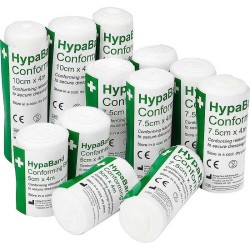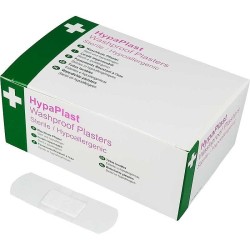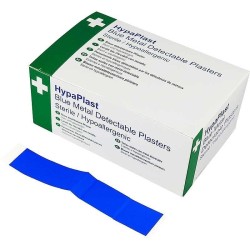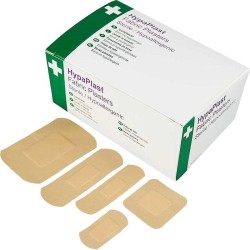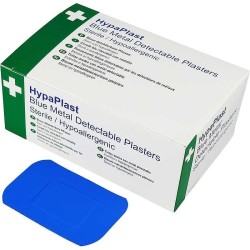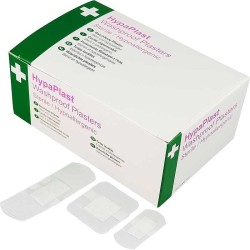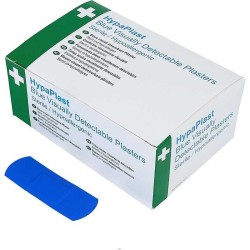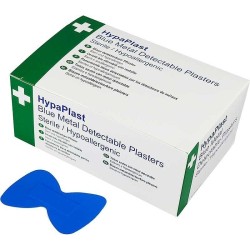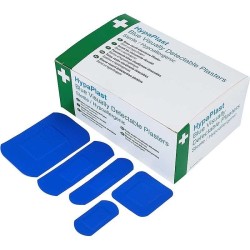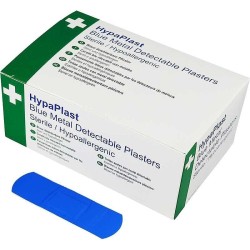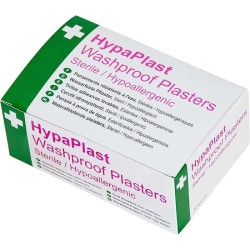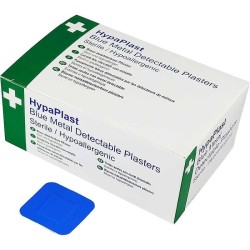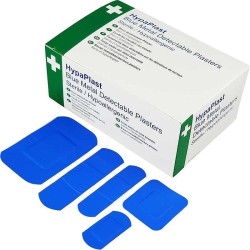First Aid Consumables
Subcategories
First Aid Plasters
Essential Wound Protection for Minor Injury Management
First aid plasters provide essential wound protection covering minor cuts, grazes, and abrasions across workplaces, care facilities, educational settings, and domestic environments throughout England, Scotland, Wales, and Northern Ireland. These fundamental first aid items encompass varied plaster types including fabric plasters offering flexibility and breathability, waterproof plasters providing moisture protection, hypoallergenic plasters for sensitive skin, blue detectable plasters for food handling environments, and specialist plasters addressing specific requirements. Organisations rely on first aid plasters for immediate minor wound protection, infection prevention through barrier provision, comfortable wound coverage, regulatory compliance particularly blue plasters in food handling, and comprehensive minor injury management. Modern first aid plasters incorporate features including strong adhesive securing plasters during activity, non-stick wound pads preventing adhesion to injuries, varied sizes accommodating different wounds, appropriate materials for different scenarios, and sterile packaging ensuring hygiene. The provision of comprehensive first aid plaster stocks demonstrates commitment to workplace safety, supports immediate minor injury management, enables appropriate wound protection, and fulfils fundamental first aid requirements across all environments.
The implementation of appropriate first aid plasters directly supports workplace minor injury management, infection prevention, and demonstration of basic safety provision. Minor wounds represent the most common workplace injuries requiring immediate protection preventing infection whilst enabling continued activity. First aid plasters address these needs by providing immediate wound coverage, infection prevention through barrier protection, comfortable coverage enabling continued activity, appropriate types for different environments particularly blue plasters in food handling, and professional minor injury management. Applications include workplace minor injury response, care facility resident injury management, educational setting student care, food handling environments requiring detectable plasters, and general minor wound protection. Organisations benefit from first aid plasters through prevented infection complications, maintained productivity through minor injury management not requiring medical attention, regulatory compliance particularly food safety in catering environments, and demonstrated basic safety provision. Modern plasters incorporate features such as enhanced adhesion, flexible materials, and antimicrobial properties throughout England, Scotland, Wales, and Northern Ireland.
Selecting and implementing first aid plasters requires assessment of organisational needs, appropriate type specification, and integration with first aid provision across environments throughout the UK. Safety managers should evaluate typical minor injuries determining required plaster types, assess specific requirements such as food handling necessitating blue detectable plasters, consider workforce characteristics including sensitive skin requiring hypoallergenic options, and calculate adequate stock levels. Plaster selection should prioritise varied types addressing different scenarios, appropriate sizes from fingertip plasters to large strips, suitable materials with fabric for flexibility or waterproof for moisture exposure, blue detectable plasters for food handling, and adequate quantities ensuring availability. Implementation protocols should encompass integration with first aid kits ensuring comprehensive plaster stocks, strategic additional stocks in high-use areas, simple restocking procedures, and documentation of stock levels. Quality assurance measures should include regular stock checks, expiry date monitoring although plasters typically have extended shelf life, usage tracking identifying high-use areas or types, and restocking procedures. Modern plaster stock management may incorporate automated reordering and usage analysis. Organisations should establish minor injury procedures including plaster application, integrate with broader first aid provision, and maintain basic documentation. Food handling environments must implement strict blue plaster policies ensuring only detectable plasters are used and clear procedures if plasters are lost. Staff education should address appropriate plaster selection, correct application techniques, recognition when more substantial dressings are required, and specific requirements such as blue plasters in food handling. Storage should protect plaster stocks whilst ensuring accessibility. By implementing comprehensive first aid plaster provision alongside appropriate protocols, organisations throughout England, Scotland, Wales, and Northern Ireland demonstrate commitment to basic safety provision, minor injury management, infection prevention, and fundamental first aid capability supporting immediate appropriate wound protection across all workplace and care environments.
First Aid Bandages
Essential Wound Support and Dressing Retention
First aid bandages provide fundamental wound management supplies enabling dressing retention, injury support, and bleeding control across workplaces, care facilities, sports environments, and first aid contexts throughout England, Scotland, Wales, and Northern Ireland. These versatile medical supplies encompass varied bandage types including conforming bandages providing flexible dressing retention, cohesive bandages offering self-adhesive support, crepe bandages delivering compression and support, elastic adhesive bandages providing firm joint stabilisation, and specialist bandages addressing specific injury scenarios. Organisations rely on first aid bandages for securing wound dressings maintaining cleanliness, providing injury support particularly sprains and strains, controlling bleeding through compression, immobilising injuries pending assessment, and comprehensive wound and injury management. Modern first aid bandages incorporate features including appropriate elasticity balancing security with comfort, varied widths accommodating different body areas, suitable lengths enabling proper application, quality materials ensuring reliability, and individually wrapped units maintaining hygiene. The provision of comprehensive first aid bandage stocks demonstrates commitment to workplace safety, supports effective injury management, enables professional first aid response, and fulfils fundamental first aid requirements across all environments with injury risks.
The implementation of appropriate first aid bandages directly supports workplace injury management, effective wound care, and demonstration of comprehensive first aid capability. Injuries requiring bandaging represent common workplace incidents from minor wounds needing dressing retention through sprains requiring support, making comprehensive bandage provision essential. First aid bandages address varied needs by securing wound dressings preventing contamination, providing compression controlling bleeding, supporting injured joints and limbs, immobilising injuries, and enabling professional injury management. Injury applications include wound care using conforming bandages for dressing retention, sprain and strain management using crepe or elastic bandages for support, bleeding control through compression bandages, sports injuries requiring cohesive bandage support, and workplace trauma demanding comprehensive bandaging capability. Organisations benefit from bandage provision through effective injury management, prevented complications through appropriate bandaging, maintained productivity through prompt injury treatment, and demonstrated comprehensive first aid preparedness. Modern bandages incorporate features such as latex-free materials, colour coding, and improved adhesion throughout England, Scotland, Wales, and Northern Ireland.
Selecting and implementing first aid bandages requires assessment of injury patterns, appropriate bandage type specification, and integration with first aid provision across organisations throughout the UK. Safety managers should evaluate typical workplace injuries determining required bandage types, assess specific scenarios such as sports activities influencing needs, consider workforce and environment characteristics, and calculate adequate stock levels ensuring availability. Bandage selection should prioritise varied types addressing different scenarios with conforming for dressing retention, cohesive for self-adhesive support, crepe for compression and support, elastic adhesive for firm joint support, and specialist types for specific needs, appropriate widths from narrow finger bandages to wide limb bandages, suitable lengths enabling proper application, and adequate quantities ensuring comprehensive stocks. Implementation protocols should encompass integration with first aid kits ensuring comprehensive bandage provision, staff training on bandaging techniques for different injury types, clear injury management procedures, and documented stock management. Quality assurance measures should include regular stock checks, usage tracking identifying high-use types, restocking procedures, and incident recording. Modern bandage stock management may incorporate inventory systems and automated reordering. Organisations should establish injury management procedures including appropriate bandage selection and application, integrate with broader first aid provision, and maintain documentation. Sports organisations require enhanced bandage stocks particularly cohesive types. Staff education should address bandage type selection for different injuries, correct application techniques including appropriate tension, circulation checking, and recognition when medical assessment is required. Storage should protect bandages whilst ensuring accessibility within first aid supplies. By implementing comprehensive first aid bandage supplies alongside professional protocols, organisations throughout England, Scotland, Wales, and Northern Ireland demonstrate commitment to workplace safety, effective injury management, comprehensive first aid capability, and professional emergency response supporting optimal injury outcomes through appropriate bandaging across all working, care, and sports environments.

